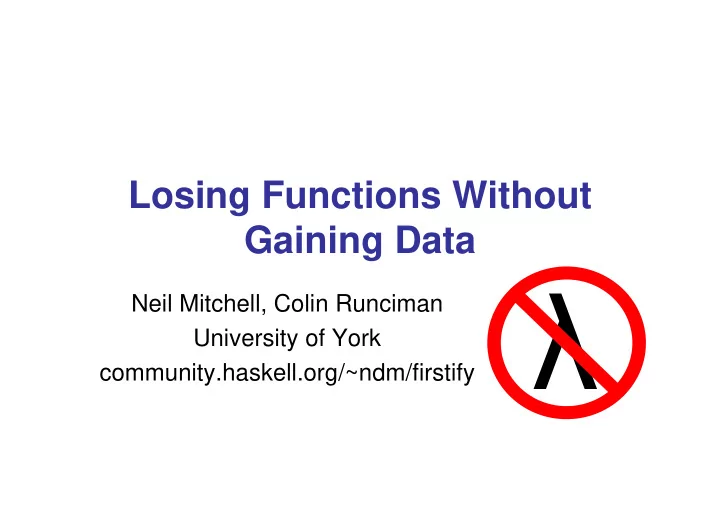

Losing Functions Without Gaining Data community.haskell.org/~ndm/firstify λ Neil Mitchell, Colin Runciman University of York
λ The Goal • Remove functional values – Only named functions defined at the top level – No under/over application • Without introducing data – Don’t want to introduce new data values – Avoid encoding functions in data
λ The Purpose • Analysis! – Termination checking – Strictness analysis – Pattern-match safety (eg. Catch, Haskell08) This paper Higher-order First-order program program Apply Analyse Analysis results
λ Example 1 sum :: [Int] → Int sum xs = foldl ( λ x y → x + y) 0 xs foldl :: (a → b → a) → a → [b] → a foldl f z [] = z foldl f z (x:xs) = foldl f (f z x) xs
λ Example 1: Result sum :: [Int] → Int sum xs = foldl + 0 xs foldl + :: a → [b] → a foldl + z [] = z foldl + z (x:xs) = foldl + (z + x) xs Ingredient: specialisation
λ Example 2 apply :: String → Int → Int apply str x = case meaning str of Just f → f x Nothing → x meaning :: String → Maybe (Int → Int) meaning “abs” = Just abs meaning _ = Nothing
λ Example 2: Result apply :: String → Int → Int apply str x = case str of “abs” → abs x _ → x Ingredients: inlining, simplification
λ The Central Idea • Introduce explicit lambdas – Makes higher-order bits easier to see • Move the lambdas around – The bulk of the work • Eliminate lambdas – Applied lambdas – Unused lambdas
λ Moving Lambdas Around Inlining Simplification Specialisation + Restrictions First-order reduction
λ Purpose of Each Stage • Simplification – Eliminate applied lambdas • Inlining – Eliminate functions returning lambdas inside constructors • Specialisation – Eliminate lambdas passed as arguments
λ Simplification • Lots of basic simplifications – eg. case/case, case of known constructor, application of a lambda • Also need these let rules – let v = x in λ w → y ⇒ λ w → let v = x in y – let v = x in y ⇒ y [x / v] , if x is a lambda or a boxed lambda
λ Boxed Lambda • Syntactic condition, under-approximates… • …expressions whose results are constructions with a lambda component Boxed Lambda’s Not Boxed Lambda’s [ λ x → x] λ x → [x] Just [ λ x → x] [foo ( λ x → x)] let y = 1 in [ λ x → x] foo [ λ x → x] [Nothing , Just ( λ x → x)] let v = [ λ x → x] in v
λ Inlining • Purpose: eliminate functions returning boxed lambdas • case f xs of … ⇒ case {body f} xs of … – where {body f} is boxed lambda
λ Specialisation • Purpose: eliminate lambdas passed to functions • Given f e 1 …e n , where some e i is a lambda or boxed lambda • Produce specialised f’ – eliminate the i th argument – introduce argument for each free variable in e i • Reformulate the application to use f’
λ Specialisation Example 1. sum xs = foldl ( λ x y → x + y) 0 xs 2. foldl + z xs = foldl ( λ x y → x + y) z xs 3. sum xs = foldl + 0 xs
λ Where the Lambdas Go • Functions returning lambdas are eta expanded • Functions returning boxed lambdas are inlined • Functions with lambda arguments are specialised • All other lambdas are targets for simplification rules No lambda can hide!
λ Termination • Specialisation may not terminate – Limited by homeomorphic embedding • Inlining may not terminate – Limited by local numeric bounds • Limits force termination when lambdas used to store an unbounded amount of information (eg. difference lists)
λ Disclaimers • Not complete: may be residual lambdas if – Termination criteria kick in – Lambdas are passed to primitive functions – Root function takes/returns lambdas • Loss of sharing f x = let i = expensive x in λ j → i + j ⇒ f x = λ j → let i = expensive x in i + j
λ Results • Successful on 62 of 66 nofib programs – Not cacheprof, grep, lift, prolog • ~0.5 seconds to transform a program – Best = 0.1, Worst = 1.2 • Average code-size reduction of 30% – Best = 78% reduction, Worst = 27% increase • Catch (Haskell08) relies on this method – 3 real bugs in HsColour
λ Results: Strictness • Ask GHC – is add’s second arg strict? add :: Int → Int → Int add x y = apply 10 (+x) y apply :: Int → (a → a) → a → a apply 0 f x = x apply n f x = apply (n - 1) f (f x)
λ Results: Termination • Ask Agda – does this terminate? cons : (N → List N) → N → List N cons f x = x :: f x downFrom : N → List N downFrom = cons f where f : N → List N f zero = [ ] f (suc x) = downFrom x
λ Conclusions • Let’s analyse higher-order programs! • Write first-order analysis pass • Old way: extend to higher-order – ~5 years for strictness analysis • New way: use defunctionalisation – ~0.5 seconds
Recommend
More recommend